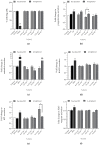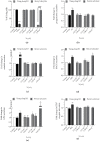Evaluation of Placental Toxicity of Five Essential Oils and Their Potential Endocrine-Disrupting Effects
- PMID: 35877416
- PMCID: PMC9323951
- DOI: 10.3390/cimb44070192
Evaluation of Placental Toxicity of Five Essential Oils and Their Potential Endocrine-Disrupting Effects
Abstract
Pregnant women may use EOs in case of morning sickness, nausea, stress management, etc. Little is known about the potential danger that EOs represent for the placenta and therefore for the pregnancy. Our aim was to explore and compare the placental toxicity and potential endocrine disrupting effects of niaouli, orange, tea tree, wintergreen and ylang-ylang EOs, and their key compounds: 4-terpineol, 1,8-cineol, limonene, methyl salicylate and benzyl salicylate. We studied the release of four hormones and the activation of P2X7 receptor in JEG-Tox human placental cells as key biomarkers for endocrine toxicity. We observed that niaouli, orange, tea tree, wintergreen and ylang-ylang EOs and their key components disrupted at least one of the studied hormones but none of them activated the P2X7 cell death receptor. The tested EOs appear then to be more hormonal modulators rather than EDCs in human placental cells. The hormonal effects observed with the key components were very different from those observed with the EOs. EOs are very complex mixtures, and it is essential to study whole EOs rather than their components individually in safety assessment.
Keywords: P2X7 receptor; endocrine disruptor; essential oil; hormones; placental toxicity.
Conflict of interest statement
S.F. is an employee of Laboratoires Léa Nature. E.O., P.L., M.D. and P.R. have no conflict of interest.
Figures





References
-
- Gupta R., Gupta R. Developmental Toxicology, Placental Toxicity. Elsevier; Amsterdam, The Netherlands: 2017. pp. 1301–1325.
-
- Williams W. Pre-Conception Care and Aromatherapy in Pregnancy. J. Clin. Aromather. 2005;2:15–19.
LinkOut - more resources
Full Text Sources

